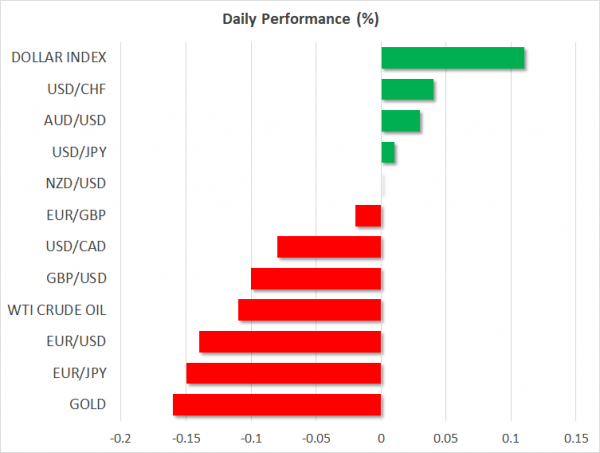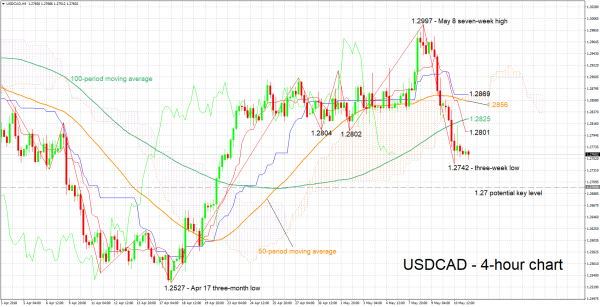Here are the latest developments in global markets:
FOREX: The US dollar index, which tracks the greenback’s performance against a basket of six major currencies, traded 0.1% higher on Friday, recouping some of the losses it posted on Thursday following weaker-than-anticipated US inflation data. The British pound recorded hefty losses on Thursday too, after the BoE played down expectations for a near-term rate increase.
STOCKS: Wall Street raced higher yesterday, after disappointing US inflation figures calmed the nerves of investors worried that the Fed may raise interest rates faster this year. The S&P 500 led the charge higher, climbing by 0.94%, while the Nasdaq Composite and the Dow Jones followed in its tracks, gaining 0.89% and 0.80% respectively. As for today, futures tracking the Dow, S&P, and Nasdaq 100 are currently flashing red, pointing to a slightly lower open. In Asia, most major indices took their cue from their US counterparts and surged. Japan’s Nikkei 225 and the Topix rose by 1.16% and 0.98% correspondingly, while in Hong Kong, the Hang Seng soared 1.02%. In Europe, futures following most major benchmarks were in positive territory, albeit marginally so.
COMMODITIES: Oil prices corrected a little lower on Friday, but still remained elevated near the recent multi-year highs. WTI and Brent crude dropped by 0.1% and 0.2% respectively. Following the US decision to impose sanctions on Iran, which would throw a sizeable chunk of supply out of the market, investors appear to be shifting their focus on whether other producers can – and want to – “fill the gap” left by Iran, by raising their own production. Turning to precious metals, gold prices soared more than $10 yesterday, briefly touching the $1,322 level, before pulling back a little to $1,320 today. The gains appear to be owed mostly to the underperformance of the dollar, which sank yesterday following disappointing US inflation data. Since gold is denominated in dollars, a weaker US currency boosts demand for the metal, as it becomes cheaper for investors using foreign currencies to buy it.
Major movers: Pound drops as BoE downplays rate-hike expectations; dollar retreats after CPIs
The British pound came under renewed selling pressure yesterday, following the Bank of England’s (BoE) rate decision. While the Bank kept its policy unchanged via a 7-2 vote as was widely anticipated, it revised down both its GDP growth and its inflation forecasts, sending the message that it is in no hurry to raise rates. Policymakers acknowledged the economy’s recent slowdown, and made it clear they will sit on the sidelines for a while as they monitor whether this softness was temporary, or owed to more persistent factors.
The key takeaway from the BoE was that the hiking cycle has been delayed for now, but not derailed. The timing of the next rate increase will depend on whether economic data begin to show signs of life again in the coming months. The implied probability for a rate hike at the August meeting dropped markedly in the aftermath, and currently rests at 42% according to the UK overnight index swaps. That probability is likely to rise or fall according to the quality of incoming UK data over the next weeks, and the pound will probably move alongside it.
Over in the US, the dollar index tumbled notably, falling back below the 93.00 handle, after the CPI data for April disappointed. While the headline CPI rate ticked up to 2.5% in yearly terms as was expected, the core rate missed its forecast for inching up, and instead held steady at 2.1%. This may have led investors to scale back positions betting that inflation will accelerate further, which could push the Fed to raise rates at a more aggressive pace.
In geopolitics, US President Trump announced yesterday that he will meet North Korean leader Kim Jong Un in Singapore, on June 12.
Day ahead: Canadian jobs data and University of Michigan consumer sentiment survey on the horizon; Italian politics eyed
Friday’s calendar is a relatively light one, with Canada’s employment report and the University of Michigan’s gauge of consumer sentiment being among the highlights. Meanwhile, political developments in Italy will also be monitored by market participants.
Canadian jobs data for the month of April are due at 1230 GMT. The economy is anticipated to have added 17.4k positions during the month, below March’s 32.3k but still reflecting a healthy figure should expectations materialize. The unemployment rate is projected to remain at 5.8%, matching a near decade low. A data beat is likely to increase market expectations for a faster tightening cycle by the Bank of Canada, consequently boosting the loonie. Elevated oil prices are also seen as supporting the currency; Canada is a major oil exporter.
The US will see the release of the University of Michigan’s preliminary survey on consumer sentiment for the month of May at 1400 GMT. Consumer morale is forecast to edge slightly lower, with the relevant index standing at 98.5 from April’s 98.8. The surveys pertaining to inflation expectations have gathered interest in the past and will also be watched, especially in the aftermath of yesterday’s CPI figures which were weaker than forecasted and led the greenback to record some losses relative to other currencies. Earlier in the day (1230 GMT), US import and export prices for April will also be made public.
In Italy, it seems that the two anti-establishment parties, 5-Star Movement and Northern League, are getting closer to forming a government; euro pairs will be eyed in the event of any updates on this front.
With oil prices around their highest since late 2014, the US Baker Hughes oil rig count due at 1700 GMT might be attracting additional interest.
ECB chief Mario Draghi will be giving a speech at 1315 GMT, while earlier (1230 GMT), St. Louis Fed President James Bullard (non-voting FOMC member in 2018) will be giving a presentation on the US economy and monetary policy. Another policymaker delivering remarks today is Bank of Canada Deputy Governor Carolyn Wilkins (1310 GMT).
Also of interest will be a speech by President Trump on his administration’s plans to combat drug pricing. In this respect, stocks of pharmaceutical companies will be in focus.
Technical Analysis: USDCAD negative momentum eases a bit
USDCAD has declined considerably after touching a seven-week high of 1.2997 on Tuesday. Yesterday, the pair posted a three-week low of 1.2742. The Tenkan-sen line is below the Kijun-sen one, pointing to a bearish short-term picture. However, negative momentum seems to have eased a bit – this is supported by the flat Kijun-sen line. Notice also that the Chikou Span may be pointing to an oversold market.
A strong Canadian employment report is expected to boost the loonie, pushing USDCAD lower. Support to declines could come around yesterday’s low of 1.2742 and the 1.27 round figure in case of steeper declines.
Conversely, weak figures out of Canada are likely to push the pair higher. Resistance to advances might come around the 1.28 handle, with the region around it encapsulating the current levels of the Tenkan-sen (1.2801) and the 100-period moving average (1.2825), as well as a few bottoms from the recent past.
The direction of oil prices can also affect the pair, with higher prices seen as benefitting the loonie and vice versa.















